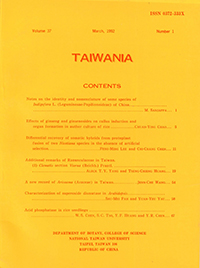Research Paper
Effects of ginseng and ginsenosides on callus induction and organ formation in auther culture of rice
Chuan-Ying Chao
Published on: March 1992
Page: 5 - 10
DOI: 10.6165/tai.1992.37.5
Abstract
Responses of cultured anthers to ginseng and plant hormones on browning and callus induction, and responses of microspore-derived calli to ginseng and ginsenosides, Rg1 and Rb1, on organ formation in rice (Oryza sativa L.) were studied. Results obtained from these studies indicated that anther browning was attributed to plant hormones and that ginseng had little effort on it. Kinetin and α-naphthaleneacetic acid were important factors for the induction of microspores to form calli in the cultured anthers while ginseng had no effort on callus induction at the concentrations tested. Ginsenosides Rg1 and Rb1 promoted organ formation in calli derived from microspores. Rg1 was more effective than Rb1 in promoting plantlet regeneration while Rb1 was effective in promoting root formation, indicating that their mode of actions in regulating organ differentiation may be somewhat different.
中文摘要
將單核小孢子期的水稻花藥與其誘發之癒合體組織培養於N6無機鹽與MS有機鹽之培養基,加以不同劑量之NAA與kinetin之人參粉末,人參皂 Rg1或Rb1等物,從而觀察花藥之褐化,癒合組織之誘導及癒合組織之分化。結果簡述如下: 1. 花藥之褐化似與植物荷爾蒙有關,人參對花藥之褐化沒有影響。 2. NAA與kinetin為誘導水稻花藥產生癒合組織之要素,人參劑量如在50-800 mg/l,則無增進癒合組織分化作用。 3. 人參粉末亦無增進癒合組織之分化作用。 4. 人參皂 Rg1與Rb1能促進癒合組織之分化。 5. Rg1能增進小植株之形成而Rb1則促進根形成。


